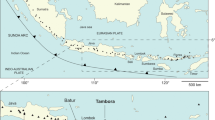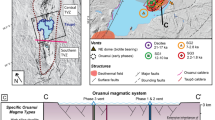Abstract
The 1783–1784 Laki tholeiitic basalt fissure eruption in Iceland was one of the greatest atmospheric pollution events of the past 250 years, with widespread effects in the northern hemisphere. The degassing history and volatile budget of this event are determined by measurements of pre-eruption and residual contents of sulfur, chlorine, and fluorine in the products of all phases of the eruption. In fissure eruptions such as Laki, degassing occurs in two stages: by explosive activity or lava fountaining at the vents, and from the lava as it flows away from the vents. Using the measured sulfur concentrations in glass inclusions in phenocrysts and in groundmass glasses of quenched eruption products, we calculate that the total accumulative atmospheric mass loading of sulfur dioxide was 122 Mt over a period of 8 months. This volatile release is sufficient to have generated ∼250 Mt of H2SO4 aerosols, an amount which agrees with an independent estimate of the Laki aerosol yield based on atmospheric turbidity measurements. Most of this volatile mass (∼60 wt.%) was released during the first 1.5 months of activity. The measured chlorine and fluorine concentrations in the samples indicate that the atmospheric loading of hydrochloric acid and hydrofluoric acid was ∼7.0 and 15.0 Mt, respectively. Furthermore, ∼75% of the volatile mass dissolved by the Laki magma was released at the vents and carried by eruption columns to altitudes between 6 and 13 km. The high degree of degassing at the vents is attributed to development of a separated two-phase flow in the upper magma conduit, and implies that high-discharge basaltic eruptions such as Laki are able to loft huge quantities of gas to altitudes where the resulting aerosols can reside for months or even 1–2 years. The atmospheric volatile contribution due to subsequent degassing of the Laki lava flow is only 18 wt.% of the total dissolved in the magma, and these emissions were confined to the lowest regions of the troposphere and therefore important only over Iceland. This study indicates that determination of the amount of sulfur degassed from the Laki magma batch by measurements of sulfur in the volcanic products (the petrologic method) yields a result which is sufficient to account for the mass of aerosols estimated by other methods.
Similar content being viewed by others
Author information
Authors and Affiliations
Rights and permissions
About this article
Cite this article
Thordarson, T., Self, S., Óskarsson, N. et al. Sulfur, chlorine, and fluorine degassing and atmospheric loading by the 1783–1784 AD Laki (Skaftár Fires) eruption in Iceland. Bull Volcanol 58, 205–225 (1996). https://doi.org/10.1007/s004450050136
Received:
Accepted:
Published:
Issue Date:
DOI: https://doi.org/10.1007/s004450050136




